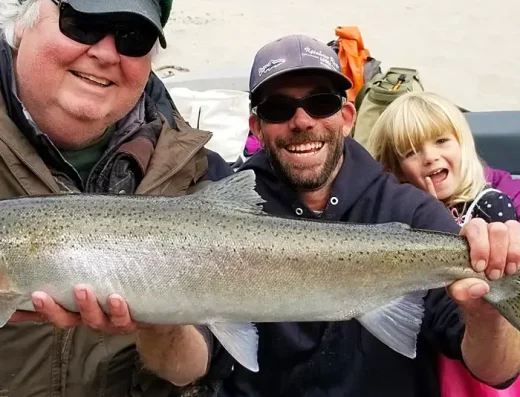Orofino Fishing Guides
Orofino fishing guides put you on the Clearwater River for steelhead, salmon, and smallmouth bass across classic Idaho runs, riffles, and tailouts.
Top Rated Fishing Guides in Orofino
TrustedFish connects anglers with proven local captains in Orofino, Idaho —no commissions, no pay-to-play listings, no BS. Every charter on our platform is invite-only, vetted for skill, local knowledge, and reputation. If they’re listed, they’ve earned it.
Orofino, ID Fishing Guide
This town sits right along the Clearwater, and the river is the heartbeat of the fishery. Most guides here run drift boats or jet sleds, offering half-day and full-day trips depending on the target. Runs are short—access points like Pink House or Clearwater Crossing put you close to the action. The river’s structure includes long gravel bars, deep bends, and slot water that fish stack into depending on flows and time of year.
Fall and winter are all about steelhead and late-season Chinook. Guides typically side-drift eggs or bobber-dog beads, and fly anglers swing intruders on sink tips through tailouts. In spring, trout and smallmouth take over, with the bass moving into ledges and eddies as water warms. Rainbow and cutthroat trout hold in seams and foam lines, especially near the North Fork and other coldwater pockets. Summer stays productive thanks to cold flows from Dworshak Dam, keeping fish active even when air temps rise.
Techniques range from bait drifting and plug pulling to fly fishing small creeks. The North Fork and upper mainstem see light pressure and give anglers a shot at dry fly eats during the summer months. Guides bring the gear, know the flows, and understand when to move and when to sit tight. It’s not a numbers game here—it’s a timing game. And timing the Clearwater right can mean the best steelhead day of your life.
Fishing Seasons in Orofino
Spring (March–May)
Steelhead fishing wraps up in early spring, especially March. High water can push fish into soft edges, and guides shift to running plugs or slow-drifting bait near inside seams. By May, bass move shallow and trout rise in the evenings. The North Fork and tailwater sections offer solid light tackle or fly opportunities, especially with midges and early caddis hatches.
Summer (June–August)
Clear water, warm days, and cold flows make summer a solid window for bass and trout. Smallmouth hit poppers, jigs, and crankbaits, especially around rocks and current breaks. Trout feed in deeper holes and cooler seams, and fly anglers do well with hoppers, ants, and dropper rigs. Some Chinook start showing in late summer, staging lower in the system as flows drop.
Fall (September–November)
Steelhead roll in starting late September, with the bite peaking in October and November. It’s prime time—side drifting, bobber-dogging, or swinging flies all work depending on conditions. Chinook salmon are also around in early fall, especially in the deeper runs. The bass bite stays strong through early October before colder nights shut them down.
Winter (December–February)
Cold water, empty ramps, and hot steelhead—if you can tough it out. The Clearwater stays fishable thanks to Dworshak flows. Steelhead stack in winter holes and hit roe, yarnies, or beads under a float. Fewer boats, less pressure, and steady water make January and February a sleeper season for serious anglers.
Gamefish in Orofino
- Steelhead – 6–12 lbs. Targeted October through March in runs, tailouts, and seams; caught on roe, beads, or swung flies depending on flow and clarity.
- Chinook Salmon – 10–30 lbs. Spring and early fall runs hold in deep pools; hit cured eggs, plugs, or jigs back-trolled near travel lanes and structure.
- Smallmouth Bass – 1–4 lbs. Feed aggressively from May to September near boulders, banks, and submerged ledges; best on soft plastics, poppers, or crankbaits.
- Rainbow Trout – 10–18 inches. Hold year-round in tailwater zones and tributaries; fly-caught with dries, nymphs, and streamers or drifted with bait in seams.
- Cutthroat Trout – 8–16 inches. Found in upper tributaries and slower pockets; best on dry flies and light tackle during summer hatches.
- Kokanee Salmon – 10–16 inches. Stack in Dworshak Reservoir spring through summer; trolled deep using flashers and corn-tipped spinners or spoons.
- White Sturgeon – 3–7 feet. Occasional catches near Dworshak tailrace in deeper pools; fished with cut bait or shad on bottom rigs.
Orofino Fishing FAQs
When is peak steelhead season?
Late fall through winter—October to March—is the prime window. Many locals favor the cold months when pressure drops and fish settle into deep runs.
Are trips available year-round?
Yes. Guides adjust with the season, switching from steelhead to bass and trout in warmer months, and running steelhead-focused trips in winter.
Where do most fishing guides launch?
Depending on the trip, captains may fish a few miles out in the bay or travel 30–50 miles to rich offshore grounds..
Can I bring my own gear?
Absolutely. Most guides provide everything, but if you have your own rod or flies you prefer, bring them along.
Is this area beginner-friendly?
Yes. Many guides welcome first-timers and walk you through the techniques, especially during the warmer trout and bass seasons
Are licenses included with the trip?
No. You’ll need to buy an Idaho fishing license, and if you’re targeting steelhead or salmon, a permit is required too.
Can I fly fish the Clearwater?
You can, especially during fall steelhead season and summer trout windows. Swinging, dry-dropper, and indicator rigs all work.
What should I wear on a winter trip?
Layer up—base layers, waterproof shells, gloves, and a warm hat. Most guides provide heaters in drift boats or sleds.
Is Dworshak Reservoir worth fishing?
Yes, especially for kokanee and smallmouth. It’s a deep, clear lake that holds solid fish when the river runs high.

